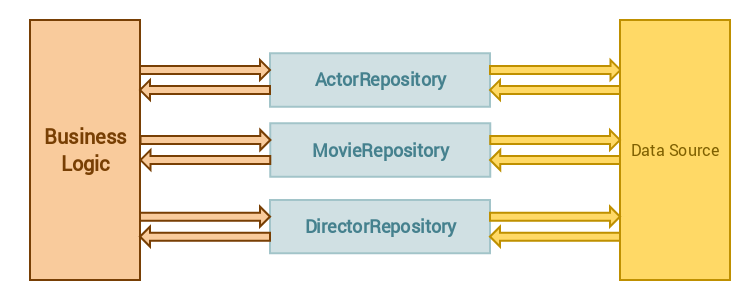如何在Laravel5.8中正确地应用Repository设计模式
- 作者: 压力山大3702532
- 来源: 51数据库
- 2020-08-11
在本文中,我会向你展示如何在 Laravel 中从头开始实现 repository 设计模式。我将使用 Laravel 5.8.3 版,但 Laravel 版本不是最重要的。在开始写代码之前,你需要了解一些关于 repository 设计模式的相关信息。

repository 设计模式允许你使用对象,而不需要了解这些对象是如何持久化的。本质上,它是数据层的抽象。
这意味着你的业务逻辑不需要了解如何检索数据或数据源是什么,业务逻辑依赖于 repository 来检索正确的数据。
关于这个模式,我看到有人将它误解为 repository 被用来创建或更新数据。 这不是 repository 应该做的,repository 不应该创建或更新数据,仅仅用于检索数据。
理解透了吧?接下来一起写代码
既然我们从头开始,那么我们先创建一个新的 Laravel 项目吧:
composer create-project --prefer-dist laravel/laravel repository
对于本教程,我们将构建一个小型的博客应用。现在我们已经创建好了一个新的 Laravel 项目,接下来应该为它创建一个控制器和模型。
php artisan make:controller BlogController
这将在 app/Http/Controllers 目录中创建 BlogController 。
php artisan make:model Models/Blog -m
提示:
-m 选项会创建一个对应的数据库迁移,你可以在 database/migrations 目录中找到所生成的迁移。
现在你应该能在 app/Models 目录中找到刚生成的模型 Blog 了吧。这只是一种我喜欢的存放模型的方式。
现在我们有了控制器和模型,是时候看看我们创建的迁移文件了。除了默认的 Laravel 时间戳字段外,我们的博客只需要 标题、内容 和 用户 ID 字段。
<?php
use Illuminate\Support\Facades\Schema;
use Illuminate\Database\Schema\Blueprint;
use Illuminate\Database\Migrations\Migration;
class CreateBlogsTable extends Migration
{
public function up()
{
Schema::create('blogs', function (Blueprint $table) {
$table->bigIncrements('id');
$table->string('title');
$table->text('content');
$table->integer('user_id');
$table->timestamps();
$table->foreign('user_id')
->references('id')
->on('users');
});
}
public function down()
{
Schema::dropIfExists('blogs');
}
}
提示:
如果你使用的是 Laravel 5.8 以下的旧版本,请将
$table->bigIncrements('id');
替换为:
$table->increments('id');
设置数据库
我将使用 MySQL 数据库作为示例,第一步就是创建一个新的数据库。
mysql -u root -p create database laravel_repository;
以上命令将会创建一个叫 laravel_repository 的新数据库。接下来我们需要添加数据库信息到 Laravel 根目录的 .env 文件中。
DB_DATABASE=laravel_repository DB_USERNAME=root DB_PASSWORD=secret
当你更新了 .env 文件后我们需要清空缓存:
php artisan config:clear
运行迁移
现在我们已经设置好了数据库,可以开始运行迁移了:
php artisan migrate
这将会创建 blogs 表,包含了我们在迁移中声明的 title , content 和 user_id 字段。
实现 repository 设计模式
一切就绪,我们现在可以开始实现 repository 设计风格了。我们将会在 app 目录中创建 Repositories 目录。我们将要创建的第二个目录是 Interfaces 目录,这个目录位于 Repositories 目录中。
在 Interfaces 文件中我们将创建一个包含两个方法的 BlogRepositoryInterface 接口。
- 返回所有博客文章的 all 方法
- 返回特定用户所有博客文章的 getByUser 方法
<?php
namespace App\Repositories\Interfaces;
use App\User;
interface BlogRepositoryInterface
{
public function all();
public function getByUser(User $user);
}
我们需要创建的最后一个类是将要实现 BlogRepositoryInterface 的 BlogRepository ,我们会写一个最简单的实现方式。
<?php
namespace App\Repositories;
use App\Models\Blog;
use App\User;
use App\Repositories\Interfaces\BlogRepositoryInterface;
class BlogRepository implements BlogRepositoryInterface
{
public function all()
{
return Blog::all();
}
public function getByUser(User $user)
{
return Blog::where('user_id'. $user->id)->get();
}
}
你的 Repositories 目录应该像这样:
app/ └── Repositories/ ├── BlogRepository.php └── Interfaces/ └── BlogRepositoryInterface.php
你现在已经成功创建了一个 repository 了。但是我们还没有完成,是时候开始使用我们的 repository 了。
在控制器中使用 Repository
要开始使用 BlogRepository ,我们首先需要将其注入到 BlogController 。由于 Laravel 的依赖注入,我们很容易用另一个来替换它。这就是我们控制器的样子:
<?php
namespace App\Http\Controllers;
use App\Repositories\Interfaces\BlogRepositoryInterface;
use App\User;
class BlogController extends Controller
{
private $blogRepository;
public function __construct(BlogRepositoryInterface $blogRepository)
{
$this->blogRepository = $blogRepository;
}
public function index()
{
$blogs = $this->blogRepository->all();
return view('blog')->withBlogs($blogs);
}
public function detail($id)
{
$user = User::find($id);
$blogs = $this->blogRepository->getByUser($user);
return view('blog')->withBlogs($blogs);
}
}
如你所见,控制器中的代码很简短,可读性非常的高。不需要十行代码就可以获取到所需的数据,多亏了 repository ,所有这些逻辑都可以在一行代码中完成。这对单元测试也很好,因为 repository 的方法很容易复用。
repository 设计模式也使更改数据源变得更加容易。在这个例子中,我们使用 MySQL 数据库来检索我们的博客内容。我们使用 Eloquent 来完成查询数据库操作。但是假设我们在某个网站上看到了一个很棒的博客 API,我们想使用这个 API 作为数据源,我们所要做的就是重写 BlogRepository 来调用这个 API 替换 Eloquent 。
RepositoryServiceProvider
我们将注入 BlogController 中的 BlogRepository ,而不是注入 BlogController 中的 BlogRepositoryInterface ,然后让服务容器决定将使用哪个存储库。这将在 AppServiceProvider 的 boot 方法中实现,但我更喜欢为此创建一个新的 provider 来保持整洁。
php artisan make:provider RepositoryServiceProvider
我们为此创建一个新的 provider 的原因是,当您的项目开始发展为大型项目时,结构会变得非常凌乱。设想一下,一个拥有 10 个以上模型的项目,每个模型都有自己的 repository ,你的 AppServiceProvider 可读性将会大大降低。
我们的 RepositoryServiceProvider 会像下面这样:
<?php
namespace App\Providers;
use App\Repositories\BlogRepository;
use App\Repositories\Interfaces\BlogRepositoryInterface;
use Illuminate\Support\ServiceProvider;
class RepositoryServiceProvider extends ServiceProvider
{
public function register()
{
$this->app->bind(
BlogRepositoryInterface::class,
BlogRepository::class
);
}
}
留意用另一个 repository 替代 BlogRepository 是多么容易!
不要忘记添加 RepositoryServiceProvider 到 config/app.php 文件的 providers 列表中。完成了这些后我们需要清空缓存:
php artisan config:clear
就是这样
现在你已经成功实现了 repository 设计模式,不是很难吧?
你可以选择增加一些路由和视图来拓展代码,但本文将在这里结束,因为本文主要是介绍 repository 设计模式的。
原文地址:https://itnext.io/repository-design-pattern-done-right-in-laravel-d177b5fa75d4
以上就是本文的全部内容,希望对大家的学习有所帮助,


